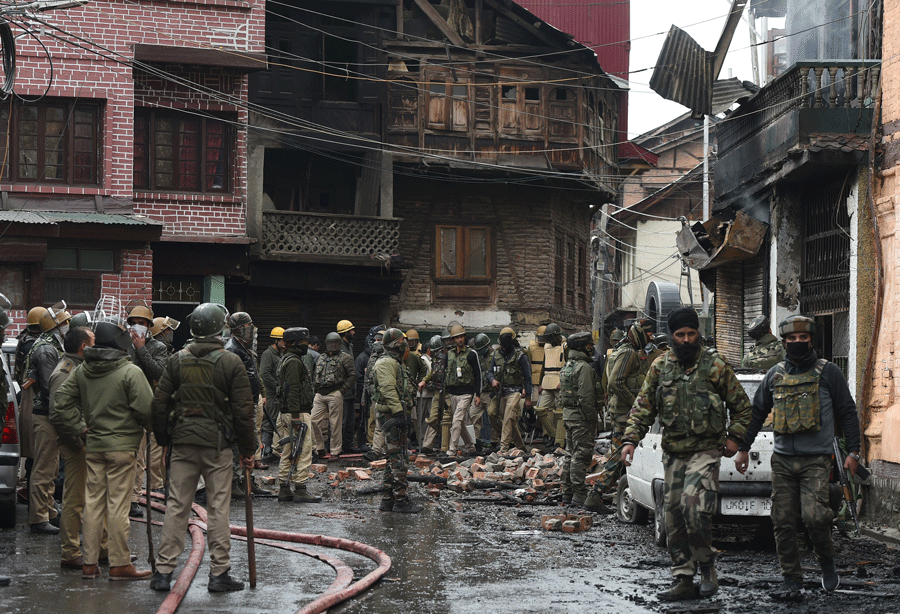Night of Despair
By Anuradha Bhasin Jamwal | Newsbeat International | Published 6 years ago

Three months ago, Kashmir witnessed the panchayat and local bodies elections that came to be infamously called the “ghost elections.” The exercise made a mockery of democracy, marked as it was by a total lack of enthusiasm on the part of both, the voters and the “invisible” candidates. Voting did not cross the single-digit figure in many constituencies. Moreover, hundreds of seats went uncontested, while elections to 1,600 seats could not be held.
 The conduct of the polls that allowed the Hindu right-wing Bharatiya Janata Party (BJP) to finally wave its saffron flag in Kashmir, for the first time, by winning some of the seats amid abysmally low polling, bears tell-tale marks of what the parliamentary polls in three constituencies in the Valley next month could possibly produce.
The conduct of the polls that allowed the Hindu right-wing Bharatiya Janata Party (BJP) to finally wave its saffron flag in Kashmir, for the first time, by winning some of the seats amid abysmally low polling, bears tell-tale marks of what the parliamentary polls in three constituencies in the Valley next month could possibly produce.
Electoral politics in Kashmir has a history of unpredictability. Many factors condition the election mood of the voters in the Valley.
Unlike the low enthusiasm witnessed during the local bodies polls, which were boycotted by the two main regional parties of Jammu and Kashmir – the National Conference (NC) and the Peoples’ Democratic Party (PDP) – over the issue of Article 370 and Article 35A, which guarantee the special status of the state under the Indian constitution, electoral campaigning in the three Lok Sabha constituencies has picked up political heat with the start of election-related rallies.
Last week the NC, the PDP and the Sajjad Gani Lone-led Peoples Conference (PC) kickstarted their rallies and former IAS officer, Shah Faesal, launched his Jammu and Kashmir People’s Movement (JKPM), which visibly looks like a Kashmiri version of the Aam Aadmi Party, pivoted as it is around the slogan of fighting corruption and the promise of strengthening the party through crowd-funding. The party held its debut rally in Srinagar. The JKPM’s participation could have led to a division of votes, but that speculation was later put to rest. Five days later, on March 23, Faesal opted out of the polls, saying that the newly launched party needed to focus instead on a mass contact programme.
The confidence of political parties was bolstered after the NC began its campaign from Khanabal in Anantnag district, which is not only a bastion of the PDP, but also a militancy-infested area. The suicide attack on February 14, that killed at least 40 security personnel and almost brought India and Pakistan to the brink of a war, took place in the neighbouring and highly volatile district of Pulwama.
The non-participation of voters during the panchayat polls, however, may not necessarily have been influenced by the presence of militants, as militancy-related violence did not have any major impact on the local government election. While the entry of the NC and the PDP in the electoral fray can improve polling, voting patterns may only improve marginally. The mood on the ground is completely at odds with the robust enthusiasm that is limited to the party offices and some committed workers. Outside these arenas, Kashmir remains an entirely different world, soaked in an endless cycle of bloodshed, grief and abject hopelessness.
In the hullabaloo of elections, Kashmir remains static and stagnant with its usual blend of restrictions, strike calls, internet bans, disrupted rail services, the shutdown of educational institutions, crackdowns, raids, arrests, flying bullets and pellets, funerals, and encounters resulting in the casualties of security men, militants and civilians. It’s the same headlines over and over again, just the numbers and the dateline change.
Back in the nineties, routine violence had dehumanised society to such an extent that all the deaths and the blood spill one saw on a daily basis was euphemistically called “a scorecard.” The levels of violence today may be much less than those witnessed over two decades ago, but the Valley is caught in a bigger bubble of hopelessness today. Frustration, anger and desperation has reached a crescendo from where a reverse journey appears extremely difficult, if not impossible.
Amidst all this brutality, life goes on – crowded markets, buses, traffic jams, weddings and all kinds of ceremonies. It’s just a normal day in a place where normalcy takes on a different definition. The normalcy of the humdrum of daily life amidst barbed wires, bunkers, stones and guns is different from that of places that have not experienced militarisation.

Separatist leader Yasin Malik in a scuffle with Indian police during a protest march.
In the run-up to the election, the situation is becoming progressively worse, as the Government of India and the Governor of Jammu and Kashmir (now under President’s rule) have taken a slew of steps. In February, the government banned a socio-religious organisation, the Jamaat-e-Islami (JI). The Jamaat is known for its fundamentalist religious ideology and for running hundreds of orphanages, madrassas and schools (some of them partially government-funded) – which have also been shut down. Despite its staunch right-wing leanings, the organisation is not considered of any significant nuisance value. The ban and seizure of its property will impact the education of thousands of children.
On March 22, the government also banned the pro-independence Jammu and Kashmir Liberation Front (JKLF), one of the first militant organisations founded by Maqbool Butt, who was hanged in Delhi’s Tihar jail in 1984. Incidentally, it was also the first one to openly declare a unilateral ceasefire during the peak years of militancy and take the leap from insurgency to a peaceful resistance struggle in 1994.
Such bans have hastened and increased the scale of raids and arrests. Hundreds are being arrested, almost on a daily basis, for having direct or indirect connections with these organisations. Some are just randomly picked up on mere suspicion, or simply as a display of the power that the government wields over the public. Teenagers, too, have not been spared and nearly 650 teachers who have links with the Jamaat now, or have done so in the past, have also been jailed. Last week, a school principal, who was arrested, was killed in custody after alleged torture. As the vicious cycle of violence continues, people are caught between the gun of the security forces and that of the militants. On March 22, in an encounter in Hajin, north Kashmir, a 12-year-old boy, held hostage by militants, was killed during a gun-fight between militants and security forces. There is simply no escape from this highly volatile situation.
Such incidents further push the people, particularly the youth, either towards militancy, or deeper and deeper into a blind alley of anger, frustration and cynicism, thus resulting in an electorate that is completely detached from the electoral process. That the government has taken these steps in the election season is indicative of the fact that there could be a method in their madness.
The BJP’s ambitions in Jammu and Kashmir are lofty. Despite the fact that the state unit of the party continues to be weak and its leaders are neither competent, nor popular, the BJP has managed to make inroads in the Hindu-majority Jammu region and Buddhist Ladakh in recent years, by invoking a communal discourse and sharpening the cleavages between communities. And now it is desperate to create a political niche for itself in the Kashmir Valley.

Kashmiris protest against the ban on the Jamaat-e-Islami.
The Lok Sabha polls in Kashmir are specifically being tailored to satiate that hunger, besides ensuring that a chaotic Kashmir provides the necessary fuel and selling-point for the election campaigning in the rest of India. By not announcing assembly polls for Jammu and Kashmir along with parliamentary elections in the rest of India, the BJP has shown signs of political expediency.
Election enthusiasm is at its peak during the assembly polls that lead to the formation of a state government. While all three rungs of governance – at the central, state and local levels – are important to ensure democratic functioning in any part of the country, it may be emphasised that the legislative elections are far more significant. They provide a state-level government that can fulfil the regional aspirations of the people and act as a buffer between the disenchanted masses and the government, in a troubled state like Jammu and Kashmir. The state government unceremoniously fell after its coalition partner, the BJP – also the ruling party in the Centre – pulled the rug, and ever since, the state has been under a prolonged spell of governor’s rule. Even until the Pulwama attack on February 14, the governor had repeatedly maintained that the militancy-related situation in Kashmir was improving. However, despite such assurances, there was no attempt to announce the assembly polls.

Indian paramilitary troops guard a polling station in Srinagar.
By opting out of holding assembly and parliamentary polls simultaneously only in the case of Jammu and Kashmir, the BJP is trying to ensure that polling remains as low-key as possible. Several other steps are likely to aid this possibility. Post-Pulwama, the security of several political leaders and activists was withdrawn and this may impact their mobility, which is crucial for campaigning. Additionally, the government is now mulling over the possibility of clubbing together at least five to ten polling stations in one place, making the long travel to rural areas intimidating even for the those who are eager to vote. The militancy-infested Anantnag constituency is going to the polls in three phases, which is unprecedented and raises a strong possibility of manipulation in the polls in this highly militarised zone.
With a process aimed at a low voter-turnout, coupled with the factor of a division of votes among regional parties, the BJP stands to gain. The only other political factor that may end up fulfilling this saffron ambition is, ironically, the Congress, which is contesting two of the Valley’s three parliamentary seats, despite having entered into an alliance with the NC.

Jamaat-i-Islami supporters in IAK protest against the killing of Muslims.
Interesting electoral developments in the other three parliamentary constituencies of Ladakh and Jammu, also merit attention. While the NC will be backing its alliance partner, the Congress, in these three seats, the PDP has decided not to field any candidates from the three constituencies, averring that “it did not want a split in secular votes.” There is speculation that Ladakh’s Union Territory Front may field a candidate unitedly, leaving the BJP in a quandary. Such unprecedented electoral bonhomie between political adversaries on ideological grounds, could blunt the BJP game and throw a spanner in its ambitions.
How this drama finally pans out will be a lot clearer by the end of April, when most of the polling phases will be over. However, one thing is amply clear: these sham polls will be meaningless in the Valley, where misery, grief, frustration and a sense of hopelessness have spiralled beyond control.
Anuradha Bhasin Jamwal is the Executive Editor of Kashmir Times


